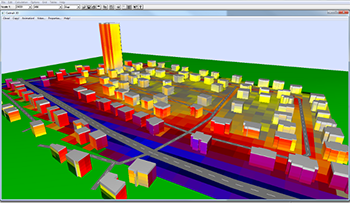CadnaA – Environmental Noise Prediction Software by DataKustik
CadnaA is state-of-the-art software for modeling, calculation, and assessment of environmental noise. It can be used efficiently at any scale, from a few single receivers in a neighborhood to noise mapping projects of entire countries. This works for various source types such as roads, railways, aircraft, or industrial noise. Whether your objective is to study the noise emission of an industrial plant, a new road, a railway scheme, or even entire towns and urbanized areas, CadnaA is designed to handle it all. With more than 30 implemented standards and guidelines, powerful calculation algorithms, extensive tools for object handling, outstanding 3D visualization, and a very user-friendly interface, CadnaA is the perfect software to handle national and international noise calculation and noise mapping projects of any size.
What’s new in CadnaA 2022 MR2?
• Implementation of Quality Assured CNOSSOS-EU, state-of-the-art Directives 2021/1226 EU and 2020/367
• Integrated default library with the latest road- and railway datasets for CNOSSOS calculations.
• New Feature “Template” to set up the whole configuration of calculations (and more) for your application.
• Calculation method SonRoad18: Implementation of further developments and supplements published in 2020/2021
• Implementation of the new Chinese calculation methods HJ2.4 2021 for industry, road, and railway.
• New Google Maps Interface, based on Microsoft Edge (Chromium) browser.
Download the CadnaA Technical Specifications
Due to its numerous features, CadnaA is the most powerful noise calculation and noise mapping software available. Every feature has been designed to ensure that projects can be handled in the most convenient and efficient way. The easy-to-use interface with self-explanatory symbols and a clear command structure always help to keep an overview even with these numbers of features and possibilities. CadnaA has a multi-lingual user interface and comes with comprehensive documentation. CadnaA is copy protected by a local USB dongle. A server dongle for network licenses is available as an option.
-
- CadnaA’s feature list includes:
- Grid noise maps (horizontal + vertical)
- Building noise maps
- Dynamic noise maps
- Grid calculations
- Distributed calculation (PCSP)
- Multithreading
- GIS integration
- Dynamic 3D View
- Report designer
- Numerous import and export interfaces such as:
-
-
- AutoCAD DXF
- ArcView Shape
- MapInfo
- SketchUp
- ASCII
- QSI
- and more
-
To serve customer needs in an individual and convenient way, there are three different product versions available:
- CadnaA Standard – allows for the calculation of noise from industrial, road, and railway sources. This configuration comes with all calculation standards for these noise types.
- CadnaA Basic – allows for the calculation of noise from industrial, road, and railway sources. This configuration comes with one calculation standard of choice for each of the noise types. Additional standards may be subsequently added for an additional cost.
- CadnaA Modular – this package is tailored for customers that don’t have the need to model all industrial, road, and railway sources. With this configuration, for instance, customers can choose the Module Industry to model industrial noise sources only. Each noise type comes with one calculation standard of choice. More standards may be subsequently added for an additional cost.
- CadnaA Modular Light – this package is similar to CadnaA Modular with the number of sources limited to 30 for roads, railway, area sources, and line sources each and up to 50 for point sources.
- Option BMP: Bitmap and other Interfaces – Import various bitmap formats. This option includes direct access to Google Earth (Import/Export) With option BMP bitmap-files can be imported in various formats to serve as background pictures. The most common application is importing scanned maps used as a template for entering sound sources, receiver points and other objects. Furthermore, digital or digitized photographs (orthophotos) in TIFF or JPEG format can be imported.
- Option BPL: Backtracking of Sound Power Levels – Option BPL is very useful in calibrating area sources of which the pressure level at distinct receiver points is known or has been measured, while the sound power level (SPL) or the SPL per unit area is unknown. Option BPL can even handle situations with several area sources and receiver points by applying a user-definable optimization strategy.
- Option SET: Sound Emission and Transmission – With the expert system Option SET sound power spectra can be automatically generated based on technical system parameters of a sound source (e.g. electric power in kW, volume flow in m3/h, rotations in 1/min etc.). Thus a unique system capable of modeling various kinds of sound sources is achieved.
- Option APL: Air Pollution – Calculate air pollution for more than 50 pollutants for industrial and road sources
- Option FLG: Aircraft Noise – Calculate noise propagation from aircrafts
- Option FLG: Radar Tracks – Use radar tracks (Fanomos, Stanly, Topsonic) for aircraft noise calculations. Group assignment is done via ICAO code.
- Option X: Extended Features – A feature-pack especially for noise mapping. It contains the features Object-Scan, Population Density, Monetary Evaluation, Map of Conflicts, Close Polygons Automatically, Delete Height Points
- Option L: Large Scale Projects – Calculate with an unlimited number of screening objects.
- Option XL: Noise Mapping – Combination of options X and L
- Option MITHRAAssure compatibility of calculation results with the French program MITHRA.
- Option Pro: Support of up to 2048 GB RAM*. 64‐bit program version*. Multithreading up to 64 cores*. Additional tools to speed up and facilitate your work like e.g.: Migration assistant, Transfer attributes, Find errors in DTM, Thin out height points, Automatic closing of polygons. *Requires 64‐bit operating system.
The following calculation standards are implemented in CadnaA
Supported Calculation Standards for Industrial Noise
- ISO 9613 (International, EC-Interim, most common)
- CONCAWE (International)
- VDI 2714, VDI 2720 (Germany)
- DIN 18005 (Germany)
- ÖAL Richtlinie Nr. 28 (Austria)
- BS 5228 (United Kingdom)
- Nordic General Prediction Method (Scandinavia)
- Nord 2000 (Scandinavia)
- Ljud från vindkraftver (Sweden)
- Harmonoise (International)
- NMPB08 – Industry (France)
- CNOSSOS-EU
- HJ 2.4 (2009, China)
Supported Calculation Standards for Road Noise
- TNM (USA, pending approval from FHWA)
- NPPB-Routes-96 (France, EC-Interim)
- NMPB – Routes -08 (France)
- RLS-90, VBUS (Germany)
- DIN 18005 (Germany)
- RVS 04.02.11 (Austria)
- STL 86 (Switzerland)
- SonRoad (Switzerland)
- CRTN (United Kingdom)
- TemaNord 1996:525 (Scandinavia)
- Czech Method (Czech Republic)
- CNOSSOS-EU
- HJ 2.4 (2009, China)
Supported Calculation Standards for Railway Noise
- FTA/FRA (USA)
- RMR, SRM II (Netherlands, EC-Interim)
- Schall03 (1990, Germany)
- Schall03 (2014, Germany)
- DIN 18005 (Germany)
- ONR 305011 (Austria)
- Semibel (Switzerland)
- NMPB-Fer (France)
- CRN (United Kingdom)
- TemaNord 1996:524 (Scandinavia)
- NMPB08-Fer (France)
- CNOSSOS-EU
Standards and Guidelines for Aircraft Noise
- INM 7.0, Integrated Noise Model (International)
- ECAC Doc. 29, 2nd edition 1997 (International, EC-Interim)
- ECAC Doc. 29, 3rd edition (International, EC-Interim)
- ICAN / AzB 2008 (Germany)
- AzB 1975 , AzB-MIL, LAI-Landeplatzleitlinie, VBUF (Germany)
- DIN 45684 (Germany)
- AzB (Germany)
- CNOSSOS-EU
The following video shows the main features of Option L:
– Unlimited number of buildings and screening objects per calculation.
The following video shows the main features included in the Option SET:
– Calculation of frequency spectra of radiated sound power determined from the technical parameters of a sound source.
– Modeling of complex devices with multiple sound sources and radiating areas, reproducing their inner sound flux and transmission to connected parts.
– User-defined sound source models.
The following video shows the main features included in the Option APL:
– Calculation of air pollutants distribution for more than 50 pollutants, e.g. PM-10 (fine particles), NO2, NOx, SO2, Benzene, As, Cd, Pb, odor.
– Exposure maps for all above named air pollutants for industrial and road sources.
– Import of annual or multi-annual statistics of meteorological parameters.
– Standardized emission factors for road traffic.
The following video shows the main features included in the Option FLG:
– Calculation of Noise Contours around airports
– Generation of Noise Protection Zones in the vicinity of airports
– Aircraft Noise results can be combined with all other noise types (Industry, Road, Railway)
– The option includes one calculation standard or guideline
– Requires CadnaA Standard or CadnaA Basic
The following video shows the main features included in the Option FLG-Radar Tracks*: (Option FLG-Radar Tracks requires Option FLG)
– Import of Radar data (Fanomos, Stanly, Topsonic, User – defined)
– Aircraft Noise calculation based on Radar data
– Group classification according to ICAO-Code
– Radar data clean-up
– Radar data filtering: time period selection, type of track (departure / approach), based on type of aircraft, runway and based on attributes.
The following video shows the main features included in the Option X:
– Extended features for analysis and postprocessing, especially valuable for e.g. noise mapping: Object Scan, population density estimation, monetary evaluation, conflict maps.
– Lua scripting language for automation of CadnaA tasks and many more user-definable customized functionalities.
– Automatic closing of building polygons
– Automatic simplification of dense terrain (height points)










